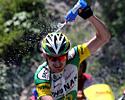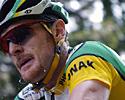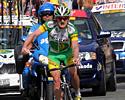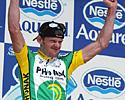
Recently on Cyclingnews.com |
Tour de France news feature, July 22, 2006
The science behind an exploit
Earlier during the Tour we talked to Floyd Landis’ training adviser Allen Lim about the Phonak rider’s form and preparation for the race. His storming ride back into contention during stage 17 prompted another chat; what tactics, mental approach and power outputs came into play on the twisting, gruelling road to Morzine? Cyclingnews’ Shane Stokes reports.

|
|
Comparing to Merckx Floyd Landis’ ride on stage 17 will undoubtedly go down as one of the exploits of Tour de France history. The American attacked alone 72 kilometres after the start, opening up a large lead on the first category Col de Saisies and remaining out front for the remainder of the 200.5 kilometre stage. Landis’ collapse on the previous day’s summit finish to La Toussuire meant that he had started the day 8’08 off yellow, but his dominant ride saw him race right back into contention and end the day just 30 seconds down.
Although comparisons were drawn between this and other long distance, stage winning exploits such as those by Merckx in 1971 and Chiappucci in 1992, Landis’s performance and final winning margin was probably closer to that recorded by Merckx during the 1969 Tour. En route to his first Tour overall win, the Belgian attacked on the climb of the Tourmalet, a full 130 kilometres from the end of the stage and, defying instructions from his team manager to ease back, powered on alone to reach the finish in line in Mourenx-Ville-Nouvelle a full eight minutes clear of the next rider.
In terms of bouncing back from a low overall position, though, the closest may be the performance by Charly Gaul in 1958, in the Chartreuse Massif. The Luxembourger had lost ten minutes due in part to mechanical problems and conceded time elsewhere, starting the final mountain stage sixth, a massive 16’03 behind Raphaël Géminiani.
However the torrential rain and freezing conditions encountered on the road to Aix les Bains was perfect for Gaul, who thrived in such weather. He attacked on the Luitel, approximately 100 kilometres from the finish, and ended the stage 7’50 ahead of the next rider, Jean Adriaenssens. Crucially, Géminiani finished back in 7th and lost 14'35". By the start of the final time trial, Gaul was just 1’07 behind new leader Vito Favero and 39” off Géminiani, but he eclipsed both in the race against the clock to win the Tour.
If Landis does the same in the stage 19 time trial and avoids mishap on Sunday, he can complete that historical parallel from 48 years ago. |
At 17.34 on Wednesday evening Floyd Landis’ Tour hopes seemed to be finally over. He had started the day ten seconds clear of Oscar Pereiro (Caisse d'Epargne-Illes Balears) and a full 2’02 up on Cyril Dessel (AG2R-Prevoyance) and every expectation was that he would continue to extend his lead in the two remaining Alpine stages. However Landis suffered a dramatic collapse on the final climb up to the 1,690 metre summit finish of La Toussuire, losing 8’23 to the other overall contenders and ending the day 11th overall, 8’08 down.
Game over. Jersey gone. C’est fini.
Or so we thought. Landis, though, had other ideas. Theories abounded as to what could have happened; hunger knock, heat exhaustion, his dodgy hip. The Phonak rider put it down simply to a non-specific ‘bad day,’ the notorious un jour sans which is the fear of every Tour contender, and vowed to go down fighting. On Thursday he came out all guns blazing, attacked 72 kilometres after the start, caught and dropped each of the 11 riders who were clear in a breakaway group and reached the finish in Morzine 5’40 ahead of Carlos Sastre (CSC) and 7’08 up on maillot jaune Oscar Pereiro. Once the various time bonuses were factored in to the post-stage equation, he ended the day third overall, just 30 seconds off the race lead. It was a spectacular turnaround.

|
"Floyd went to bed last night knowing that he was the best athlete here and also being angry with himself for having such a bad day," his training advisor and physiologist Allen Lim told Cyclingnews on Thursday evening. "He woke up again this morning still feeling angry, and had something to prove.
"Even if he was going to lose the Tour de France, he was determined to show them how to ride and make everybody work for it. His line was basically, I may lose the Tour, but they are sure going to have to earn it."
Landis said afterwards that his radio malfunctioned on the final climb of the Joux Plane due, he felt, to the amount of water he poured over his head and jersey en route to his first ever Tour stage win. He therefore had no idea of his gap while on the run-in to the finish; however, once the other riders came in, he realised just how well the day had worked out. Suddenly he was back in the hunt and with his strong time trail abilities, overall victory in the Tour once again seems very possible.
Lim was very impressed by what he saw. “ It was an incredible performance,” he stated, admiration in his voice. “Today wasn’t about cycling, today’s effort transcended cycling. It was one of the most human, incredible efforts I have ever seen. Bottom line, it was one of the best moments in sport I have ever witnessed. It was incredible.”

|
One of the enduring memories of the exploit is that of Landis riding flat out while holding a water bottle in his hand. Every couple of minutes, that bottle would be tipped over his head and jersey and, when empty, chucked away to be replaced almost immediately by another one. Lim estimated that Landis went through a massive 70 bottles during his ride, rehydrating inside and out and also eating regularly. While he had a very tough day out front, this was one clear advantage over those back in the bunch with less available support.
"I think that absolutely makes a difference on a stage like today’s,” he said. “This morning I made a list of everything that I thought went wrong and also asked him to weigh himself. He didn’t know what I was at, but when he stepped on the scales I had brought, it showed that his body weight was pretty low, as compared to what we would expect it to be [implying dehydration - ed.]. We looked at it and then I said, ‘make sure that you don’t lose any weight today.’ He got it, he knows, he is a smart guy.”
Pouring water on himself helped keep his jersey and helmet wet for much of the stage, something Lim says is advantageous. “ It is not only important to drink as much as possible, but if you have access to water, it is important to keep yourself wet like that in order to keep your core temperature down. That water was ice cold, too.

|
"You drink because you sweat. Sweat evaporates and cools you off, but the same thing can occur by keeping wet in the heat. This offers enormous differences. At the power output he is putting out, the number one factor limiting performance is theromoregulation, heat dissipation. Basically, in the body blood is used for two reasons; it is used to transport oxygen, but it is also used to cool your body down. If you can keep the body cool, then you will have that much more blood going into driving your legs.”
The obvious question then was, did the team think that Landis’ problem on La Toussuire was to do with the heat?
"It is a possibility but we will never know for sure,” Lim answers. “You could come up with 30 different reasons but those reasons don’t matter at the end of the day, once the result is done. What matters is that you don’t make the same mistakes again. And what matters too is that you get on with it, live and learn.”
Landis had a beer to relax on Wednesday evening (‘just one,’ he said) and came back out fighting to pull off that exploit. Lim has been doing daily updates for Bicycling during the race and thanks to Landis’ decision to allow his Powertap information to be published there, the data from his ride can be readily seen.

|
It makes for fascinating reading. When he made his move on the Col des Saisies he averaged 544 watts in the first thirty seconds of his acceleration. This settled down to a 5-minute peak of 451 watts, which then continued for 10 minutes at an average of power of 431 watts. His 30 minute average was 401 watts.
Precise measurements for the exploits of riders such as Coppi, Gaul, Merckx and Hinault are of course unavailable, but in this modern era the use of power meters – and the willingness of some riders such as Landis to share this information – means that we can get a clearer idea of what is happening under the bonnet.
Lim gives more details. “Floyd averaged 280 watts for the entire ride, but it was 318 for the last two hours. That is while the bike is moving, so you have take into account that he has all those long descents,” he said. “On the descents he spent 13.2 percent of his time or 43 minutes coasting. If you spend that much coasting but are as good a descender as he is, you are making up time on the descents as well.
"However, if we don’t include the coasting time, he averaged 324 watts while pedalling for the stage and 364 watts over the last two hours. That gave him a total of 5,456 Kjoules of work, at an average cadence of 89 rpm. The nature of it is that everything he did today is within the realms of physiological capacity. It was the style with which he did it, the panache and the bravado and the courage [which stood out].
"That is the thing about sport… there is nothing special about what each of us possesses except how we are going to showcase that to the world, how we can display that.”

|
Despite the outcome of the ride, Lim said that the outputs weren’t actually the best he has seen from Landis. Of course, two and a half weeks of racing will tend to have that effect.
"No, they weren’t the best. But you know what, it was ballsy. That is the thing. He has done better in training and he has done better at [individual] points during this Tour. But the thing is that he was so motivated and also that they didn’t chase. They let it go. He stuck it in their face and he got away with it.
"Personally, I think that this is just a great start for cycling because you are going back to the days of Hinault and Merckx. I think the Armstrong era was one of wheel following and people conserving energy. Floyd certainly rode that way for the first half of this Tour, but I am almost so glad that the bad day happened as it taught him that he had so much more. He was never at his limit in this race [prior to Wednesday – ed.]. Then he has this bad day, everything goes kaput, he is so angry and he knows that he has so much more. You screw up and then you try harder.”
Finally, how confident is Lim now? Landis is just 30 seconds off the race lead and has 57 kilometres of solo time trialling on Saturday to reclaim the yellow jersey.
"He is going to win,” is the reply. “That is the bottom line. He is not going to let anyone take this from him, not after today’s effort. This is his Tour.”

